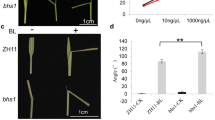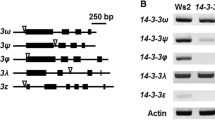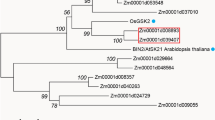Abstract
Leaf angle is a key factor in plant architecture and crop yield. Brassinosteroids (BRs) regulate many developmental processes, especially the leaf angle in monocots. However, the BR signalling pathway is complex and includes many unknown members. Here, we propose that Oryza sativa BRASSINOSTEROID-RESPONSIVE LEAF ANGLE REGULATOR 1 (OsBLR1) encodes a bHLH transcription factor, and positively regulates BR signalling to increase the leaf angle and grain length in rice (Oryza sativa L.). Lines overexpressing OsBLR1 (blr1-D and BLR1-OE-1/2/3) had similar traits, with increased leaf angle and grain length. Conversely, OsBLR1-knockout mutants (blr1-1/2/3) had erect leaves and shorter grains. Lamina joint inclination, coleoptile elongation, and root elongation assay results indicated that these overexpression lines were more sensitive to BR, while the knockout mutants were less sensitive. There was no significant difference in the endogenous BR contents of blr1-1/2 and wild-type plants. These results suggest that OsBLR1 is involved in BR signal transduction. The blr1-D mutant, with increased cell growth in the lamina joint and smaller leaf midrib, showed significant changes in gene expression related to the cell wall and leaf development compared with wild-type plants; furthermore, the cellulose and protopectin contents in blr1-D were reduced, which resulted in the increased leaf angle and bent leaves. As the potential downstream target gene of OsBLR1, the REGULATOR OF LEAF INCLINATION1 (OsRLI1) gene expression was up-regulated in OsBLR1-overexpression lines and down-regulated in OsBLR1-knockout mutants. Moreover, we screened OsRACK1A as an interaction protein of OsBLR1 using a yeast two-hybrid assay and glutathione-S-transferase pull-down.
Key message
The overexpression of OsBLR1 caused increased leaf angle and grain length, whereas OsBLR1-knockout mutants had the opposite phenotypes. OsBLR1 is a member in BR signalling pathway.







Similar content being viewed by others
References
Atchley WR, Terhalle W, Dress A (1999) Positional dependence, cliques, and predictive motifs in the bHLH protein domain. J Mol Evol 48:501–516. https://doi.org/10.1007/pl00006494
Bai MY, Zhang LY, Gampala SS, Zhu SW, Song WY, Chong K, Wang ZY (2007) Functions of OsBZR1 and 14–3-3 proteins in brassinosteroid signaling in rice. Proc Natl Acad Sci USA 104:13839–13844. https://doi.org/10.1073/pnas.0706386104
Bishop GJ, Koncz C (2002) Brassinosteroids and plant steroid hormone signaling. Plant Cell 14(Suppl):S97–110. https://doi.org/10.1105/tpc.001461
Bolwell GP, Butt VS, Davies DR, Zimmerlin A (1995) The origin of the oxidative burst in plants. Free Radic Res 23:517–532. https://doi.org/10.3109/10715769509065273
Chen JG et al (2006) RACK1 mediates multiple hormone responsiveness and developmental processes in Arabidopsis. J Exp Bot 57:2697–2708. https://doi.org/10.1093/jxb/erl035
Chen K et al (2019) Translational regulation of plant response to high temperature by a dual function tRNAHis guanylyltransferase in rice. Mol Plant. https://doi.org/10.1016/j.molp.2019.04.012
Cheng Y, Zhu W, Chen Y, Ito S, Asami T, Wang X (2014) Brassinosteroids control root epidermal cell fate via direct regulation of a MYB-bHLH-WD40 complex by GSK3-like kinases. eLife. https://doi.org/10.7554/eLife.02525
Dai X, You C, Chen G, Li X, Zhang Q, Wu C (2011) OsBC1L4 encodes a COBRA-like protein that affects cellulose synthesis in rice. Plant Mol Biol 75:333–345. https://doi.org/10.1007/s11103-011-9730-z
Dong H et al (2018) Genome-wide association studies reveal that members of bHLH subfamily 16 share a conserved function in regulating flag leaf angle in rice (Oryza sativa). PLoS Genet. 14:e1007323. https://doi.org/10.1371/journal.pgen.1007323
Fukuda H (2004) Signals that control plant vascular cell differentiation. Nat Rev Mol Cell Biol 5:379–391. https://doi.org/10.1038/nrm1364
Gao X et al (2019) Rice qGL3/OsPPKL1 Functions with the GSK3/SHAGGY-like kinase OsGSK3 to modulate brassinosteroid signaling. Plant Cell 31(5):1077–1093. https://doi.org/10.1105/tpc.18.00836
Guo J, Chen JG (2008) RACK1 genes regulate plant development with unequal genetic redundancy in Arabidopsis. BMC Plant Biol 8:108. https://doi.org/10.1186/1471-2229-8-108
Guo J, Wang J, Xi L, Huang WD, Liang J, Chen JG (2009) RACK1 is a negative regulator of ABA responses in Arabidopsis. J Exp Bot 60:3819–3833. https://doi.org/10.1093/jxb/erp221
Hong Z et al (2003) A rice brassinosteroid-deficient mutant, ebisu dwarf (d2), is caused by a loss of function of a new member of cytochrome P450. Plant Cell 15:2900–2910. https://doi.org/10.1105/tpc.014712
Islas-Flores T, Rahman A, Ullah H, Villanueva MA (2015) The receptor for activated C kinase in plant signaling: tale of a promiscuous little molecule. Front Plant Sci 6:1090. https://doi.org/10.3389/fpls.2015.01090
Jang S, An G, Li HY (2017) Rice leaf angle and grain size are affected by the OsBUL1 transcriptional activator complex. Plant Physiol 173:688–702. https://doi.org/10.1104/pp.16.01653
Jeong D-H, An S, Park S, Kang H-G, Park G-G, Kim S-R, Sim J, Kim Y-O, Kim M-K, Kim S-R, Kim J, Shin M, Jung M, An G (2006) Generation of a flanking sequence-tag database for activation-tagging lines in japonica rice. Plant J 45:123–132. https://doi.org/10.1111/j.1365-313X.2005.02610.x
Jiang Y, Yang B, Deyholos MK (2009) Functional characterization of the Arabidopsis bHLH92 transcription factor in abiotic stress. Mol Genet Genom 282:503–516. https://doi.org/10.1007/s00438-009-0481-3
Khush GS, Gupta P (2013) Strategies for increasing the yield potential of cereals: case of rice as an example. Plant Breed 132:433–436. https://doi.org/10.1111/pbr.1991
Kim Y, Song JH, Park SU, Jeong YS, Kim SH (2017) Brassinosteroid-induced transcriptional repression and dephosphorylation-dependent protein degradation negatively regulate BIN2-interacting AIF2 (a BR signaling-negative regulator) bHLH transcription factor. Plant Cell Physiol 58:227–239. https://doi.org/10.1093/pcp/pcw223
Li Y, Darley CP, Ongaro V, Fleming A, Schipper O, Baldauf SL, McQueen-Mason SJ (2002) Plant expansins are a complex multigene family with an ancient evolutionary origin. Plant Physiol 128:854–864. https://doi.org/10.1104/pp.010658
Li X et al (2006) Genome-wide analysis of basic/helix-loop-helix transcription factor family in rice and Arabidopsis. Plant Physiol 141:1167–1184. https://doi.org/10.1104/pp.106.080580
Liu L et al (2013) Brittle Culm1, a COBRA-like protein, functions in cellulose assembly through binding cellulose microfibrils. PLoS Genet 9:e1003704. https://doi.org/10.1371/journal.pgen.1003704
Luo X, Zheng J, Huang R, Huang Y, Wang H, Jiang L, Fang X (2016) Phytohormones signaling and crosstalk regulating leaf angle in rice. Plant Cell Rep 35:2423–2433. https://doi.org/10.1007/s00299-016-2052-5
Nagasawa N, Miyoshi M, Sano Y, Satoh H, Hirano H, Sakai H, Nagato Y (2003) SUPERWOMAN1 and DROOPING LEAF genes control floral organ identity in rice. Development (Cambridge, England) 130:705–718. https://doi.org/10.1242/dev.00294
Nam KH, Li J (2002) BRI1/BAK1, a receptor kinase pair mediating brassinosteroid signaling. Cell 110:203–212. https://doi.org/10.1016/s0092-8674(02)00814-0
Ogo Y, Itai RN, Nakanishi H, Kobayashi T, Takahashi M, Mori S, Nishizawa NK (2010) The rice bHLH protein OsIRO2 is an essential regulator of the genes involved in Fe uptake under Fe-deficient conditions. Plant J 51:366–377. https://doi.org/10.1111/j.1365-313X.2007.03149.x
Oikawa T, Kyozuka J (2009) Two-step regulation of LAX PANICLE1 protein accumulation in axillary meristem formation in rice. Plant Cell 21:1095–1108. https://doi.org/10.1105/tpc.108.065425
Qian W, Wu C, Fu Y, Hu G, He Z, Liu W (2017) Novel rice mutants overexpressing the brassinosteroid catabolic gene CYP734A4. Plant Mol Biol 93:197–208. https://doi.org/10.1007/s11103-016-0558-4
Ruan W, Guo M, Xu L, Wang X, Zhao H, Wang J, Yi K (2018) An SPX-RLI1 module regulates leaf inclination in response to phosphate availability in rice. Plant Cell 30:853–870. https://doi.org/10.1105/tpc.17.00738
Ryu H, Kim K, Cho H, Park J, Choe S, Hwang I (2007) Nucleocytoplasmic shuttling of BZR1 mediated by phosphorylation is essential in Arabidopsis brassinosteroid signaling. Plant Cell 19:2749–2762. https://doi.org/10.1105/tpc.107.053728
Ryu H, Kim K, Cho H, Hwang I (2010) Predominant actions of cytosolic BSU1 and nuclear BIN2 regulate subcellular localization of BES1 in brassinosteroid signaling. Mol Cells 29:291–296. https://doi.org/10.1007/s10059-010-0034-y
Sinclair TR, Sheehy JE (1999) Erect leaves and photosynthesis in rice. Science 283:1455. https://doi.org/10.1126/science.283.5407.1455c
Song Q, Zhang G, Zhu XG (2013) Optimal crop canopy architecture to maximise canopy photosynthetic CO2 uptake under elevated CO2—a theoretical study using a mechanistic model of canopy photosynthesis. Funct Plant Biol 40:109–124. https://doi.org/10.1071/FP12056
Tanaka A et al (2009) BRASSINOSTEROID UPREGULATED1, encoding a helix-loop-helix protein, is a novel gene involved in brassinosteroid signaling and controls bending of the lamina joint in rice. Plant Physiol 151:669–680. https://doi.org/10.1104/pp.109.140806
Tang W et al (2008) BSKs mediate signal transduction from the receptor kinase BRI1 in Arabidopsis. Science (New York, NY) 321:557–560. https://doi.org/10.1126/science.1156973
Tong H, Chu C (2009) Roles of DLT in fine modulation on brassinosteroid response in rice. Plant Signal Behav 4:438–439. https://doi.org/10.1111/j.1365-313X.2009.03825.x
Tong H et al (2009) DWARF AND LOW-TILLERING, a new member of the GRAS family, plays positive roles in brassinosteroid signaling in rice. Plant J 58:803–816. https://doi.org/10.1111/j.1365-313X.2009.03825.x
Tong H et al (2012) DWARF AND LOW-TILLERING acts as a direct downstream target of a GSK3/SHAGGY-like kinase to mediate brassinosteroid responses in rice. Plant Cell 24:2562–2577. https://doi.org/10.1105/tpc.112.097394
Ullah H, Scappini EL, Moon AF, Williams LV, Armstrong DL, Pedersen LC (2008) Structure of a signal transduction regulator, RACK1, from Arabidopsis thaliana. Protein Sci 17:1771–1780. https://doi.org/10.1110/ps.035121.108
Wang X, Chory J (2006) Brassinosteroids regulate dissociation of BKI1, a negative regulator of BRI1 signaling, from the plasma membrane. Science (New York, NY) 313:1118–1122. https://doi.org/10.1126/science.1127593
Wang ZY et al (2002) Nuclear-localized BZR1 mediates brassinosteroid-induced growth and feedback suppression of brassinosteroid biosynthesis. Dev Cell 2:505–513. https://doi.org/10.1016/s1534-5807(02)00153-3
Wang L, Feng Z, Wang X, Wang X, Zhang X (2010) DEGseq: an R package for identifying differentially expressed genes from RNA-seq data. Bioinformatics (Oxford, England) 26:136–138. https://doi.org/10.1093/bioinformatics/btp612
Wu Q, Wu D, Shen Z, Duan C, Guan Y (2013) Quantification of endogenous brassinosteroids in plant by on-line two-dimensional microscale solid phase extraction-on column derivatization coupled with high performance liquid chromatography–tandem mass spectrometry. J Chromatogr A 1297:56–63. https://doi.org/10.1016/j.chroma.2013.04.043
Xin P, Yan J, Fan J, Chu J, Yan C (2013) An improved simplified high-sensitivity quantification method for determining brassinosteroids in different tissues of rice and Arabidopsis. Plant Physiol 162:2056–2066. https://doi.org/10.1104/pp.113.221952
Yamamuro C et al (2000) Loss of function of a rice brassinosteroid insensitive1 homolog prevents internode elongation and bending of the lamina joint. Plant Cell 12:1591–1606. https://doi.org/10.1105/tpc.12.9.1591
Yin Y, Wang ZY, Mora-Garcia S, Li J, Yoshida S, Asami T, Chory J (2002) BES1 accumulates in the nucleus in response to brassinosteroids to regulate gene expression and promote stem elongation. Cell 109:181–191. https://doi.org/10.1016/s0092-8674(02)00721-3
Zhang D et al (2014) OsRACK1 is involved in abscisic acid- and H2O2-mediated signaling to regulate seed germination in rice (Oryza sativa, L.). PLoS ONE 9:e97120. https://doi.org/10.1371/journal.pone.0097120
Zhang L et al (2009) Antagonistic HLH/bHLH transcription factors mediate brassinosteroid regulation of cell elongation and plant development in rice and Arabidopsis. Plant Cell 21:3767–3780. https://doi.org/10.1105/tpc.109.070441
Zhang C, Bai MY, Chong K (2014) Brassinosteroid-mediated regulation of agronomic traits in rice. Plant Cell Rep 33:683–696. https://doi.org/10.1007/s00299-014-1578-7
Zhu XG, Long SP, Ort DR (2008) What is the maximum efficiency with which photosynthesis can convert solar energy into biomass? Curr Opin Biotechnol 19:153–159. https://doi.org/10.1016/j.copbio.2008.02.004
Author information
Authors and Affiliations
Contributions
W.Z. and Q.Z. provided funds; W.Z. and K.W. conceived and designed the experiments; K.W. performed the major experiments and data analysis; W.Z. and K.W. discussed the results and drafted the manuscript; M.L. performed the identification of blr1-D; Y.C. performed the coleoptile elongation and root elongation assays; B.Z. assisted the Y2H screening.
Corresponding authors
Additional information
Publisher's Note
Springer Nature remains neutral with regard to jurisdictional claims in published maps and institutional affiliations.
Electronic supplementary material
Below is the link to the electronic supplementary material.
Rights and permissions
About this article
Cite this article
Wang, K., Li, Mq., Chang, Yp. et al. The basic helix-loop-helix transcription factor OsBLR1 regulates leaf angle in rice via brassinosteroid signalling. Plant Mol Biol 102, 589–602 (2020). https://doi.org/10.1007/s11103-020-00965-5
Received:
Accepted:
Published:
Issue Date:
DOI: https://doi.org/10.1007/s11103-020-00965-5




